Oaks are part of nearly every landscape in North America. There are 91 species of oaks in the United States, and another 100 or so crosses between species. Choosing an oak for your landscape can be challenging with this many options. The good thing is, most nurseries only carry a few species and some cultivars. But which is best for my yard?
When we look into picking an oak tree for our landscape, there are several things to know before. What type of soil and site is it going to? Do I want it for shade or wildlife value? What type of oak tree do I pick?
There are two separate types of oak trees: red oaks and white oaks. These are the two groups that oak trees are separated into. Red oaks have pins at the ends of their margins and their acorn take two seasons to ripen. White oaks have no pins and their acorns ripen in one season.
As for site, every species of oak is different. For this reason I am going to go over 13 oaks; one nonnative and 12 native species. From these you can choose what is best for your landscape. Just remember that oaks are slow growing, but long lived.
White Oaks
As I mentioned above, white oaks have acorns that ripen in just one growing season. All oaks produce tannins, which are chemical compounds that various plants use to deter animals from eating them or their fruit. The white oak group produces less tannins than those in the red oak group, which is why white oak (Quercus alba) is used for alcohol barrels. Also, because their acorns are ripe in one season, they do not store up as many tannins, making the them more palatable to wildlife and humans.
There are 6 white oaks that do very well in the landscapes of the Central Great Plains, where we are. Let us look at each one individually.
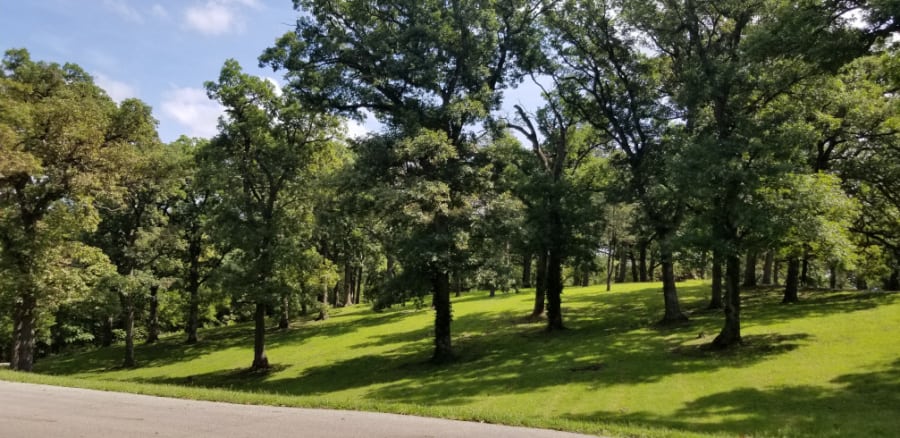
White Oak
The white oak, Quercus alba, for which the white oak group is named, is a large and majestic tree. It can be found growing native from the Missouri River eastward, throughout the country. There are many wonderful groves of white oaks scattered across the country. Here in Northeast Kansas, the biggest grove of these trees we have is in Atchison.
White oak trees grow slowly, but can reach heights of 100 feet and the canopy often spreads to 100 feet as well. They do best in open, sunny locations where they can spread out. Fall color is often red or various shades of red and orange.
The acorns of the white oak are prized by birds, squirrels, and many other animals. Even humans have used white oak acorns for consumption. Native Americans would collect the nuts, roast them, and grind them into flour. I tried this once as a child. My grandmother roasted the acorns for me and we made white oak pancakes.
Bur Oak
The bur or burr oak, Quercus macrocarpa, was long my favorite oak growing up. My grandparents loved trees as much as I did, and had a nice bur oak specimen in their backyard. That tree is still standing, and I have many fond memories of it.
Bur oaks grow natively across the Midwest and Great Plains, and up into Canada along the Great Lakes region. They can grow as big or bigger than white oaks, sometimes over 100 feet tall and wide. The national champion bur oak in West Virginia is 107 feet tall by 112 feet wide. That is a massive tree.
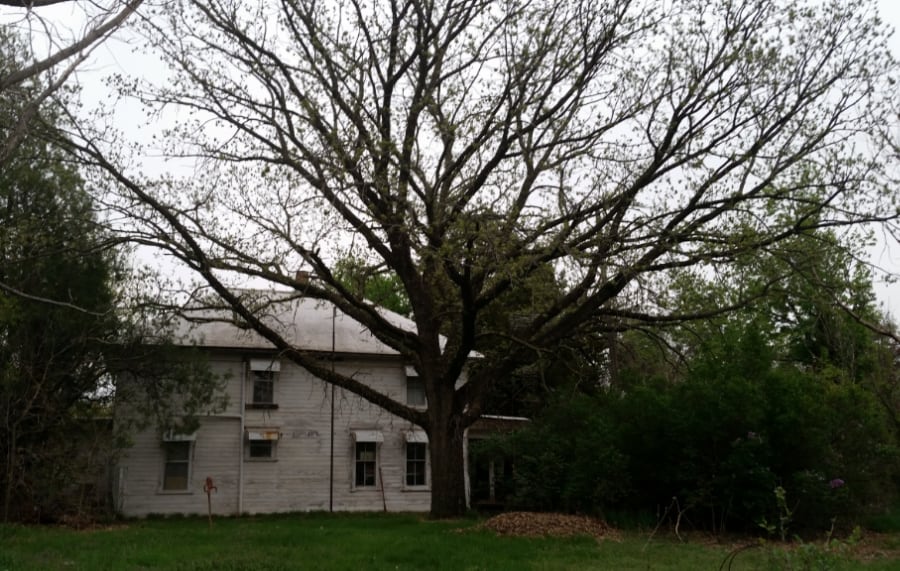
Bur oaks are not often planted in landscapes now, because their fall color is not pretty. They usually turn just brown, not pleasing for most. However, the bark on this tree is quite unique and has dark ridges that make it appealing in the landscape. The acorns of the bur oak are more than 1/2 covered by their fuzzy caps with burs, where the tree gets its name.
Chinkapin Oak
The chinkapin oak, Quercus muehlenbergii, is not often planted in landscapes, because of transplanting problems. However, it can be found growing in native woodlands, throughout the heart of the Midwest and into the Great Plains. It does very well in the part shade of taller oaks and hickories.
This oak grows up to around 50 feet tall and 80 feet wide. The best way to get one of these beauties started is to obtain acorns, which will sprout almost as soon as they are planted.
Dwarf Chinkapin Oak
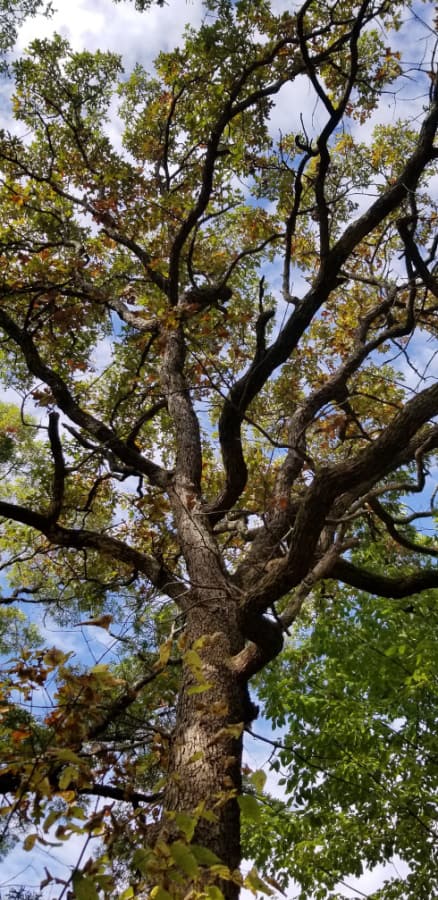
The dwarf chinkapin oak, Quercus prinoides, can be difficult to identify from chinkapin oak, when both are young. Rule of thumb is that the dwarf chinkapin oak grows in dry, rocky sites, while chinkapin grows in moist lowlands.
Dwarf chinkapins have slightly smaller leaves and acorns than the chinkapin oak and the trees are definitely smaller. They grow 15 to 25 feet tall and wide. This oak is valuable for its role in the ecosystem. It produces a large amount acorns yearly that are eaten by wildlife.
I would love to see more of this tree planted in landscapes and wildlife gardens. ‘Prairie Pioneer’ is a hardy selection, developed by North Dakota State University. It boasts extreme cold tolerance down to minus 40o F.
Post Oak
The post oak, Quercus stellata, is a nice oak tree with unique leaves. The leaves have almost square margins. Post oaks grow natively throughout the Lower Midwest, Great Plains, and the Southeastern US. They often grow on ridges above streams and waterways.
The cultivar ‘Stagecoach’ was selected by Doug Grimm from a 300 year old tree that was growing at the site of a stagecoach attack in Kansas. Post oaks grow 60 to 80 feet tall and wide.
Swamp White Oak
The swamp white oak, Quercus bicolor, is a large, showier tree than many in the white oak group. Though the leaves resemble those of chinkapin and chestnut oak, the tree has much better fall color. It is native to the Midwest and eastern Great Plains states.
Swamp white oaks grow on predominately moist soils, but is fairly drought tolerant and does very well in landscapes. It grows 60 feet tall and wide. ‘Bucks Unlimited’ is a cultivar named for its abundance of acorns for wildlife value.
Red Oaks
Trees in the red oak group usually have better fall color than most in the white oaks. However, they also produce more tannins than the white oaks, and have less of a wildlife value. But this also makes them better for landscapes in cities where less animal and insect pressures are desired.
Red oak trees also grow faster than white oak species, making them desirable over white oaks.
Red Oak
The red oak, Quercus rubra, is a nice shade tree that is an important part of the forest ecosystem. It grows natively throughout the Midwest, Great Plains, and into Canada. Red oaks have had trouble being grafted, so most in the nursery are seed grown trees.
The red oak is adaptable, tolerant of drought and dry soils. Mature specimens are 75 feet tall and wide. Fall color is reddish-orange to red. There are few if any cultivars available.
Southern Pin Oak
The southern pin oak, Quercus palustris, is perhaps one of the most widely planted oaks in the Midwest and Upper Great Plains, from Oklahoma northward. It grows quickly, especially in acidic soils, and has a nice shape. It is native in the Midwest and Central Great Plains.
Pin oaks have some issues on high pH soils, where iron is tied up by the ions in the soil that do not release it to the plant’s roots. This causes iron chlorosis which causes yellowing of the leaves and can result in death of the tree if left untreated.
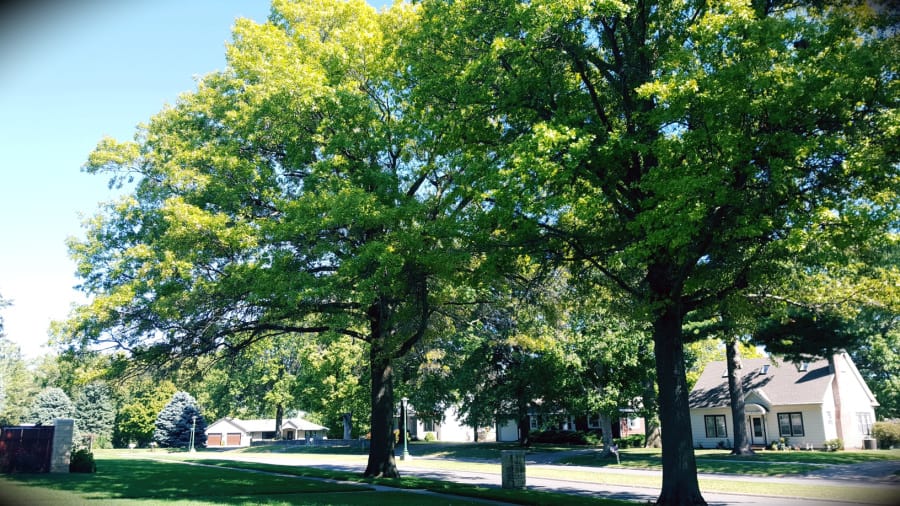
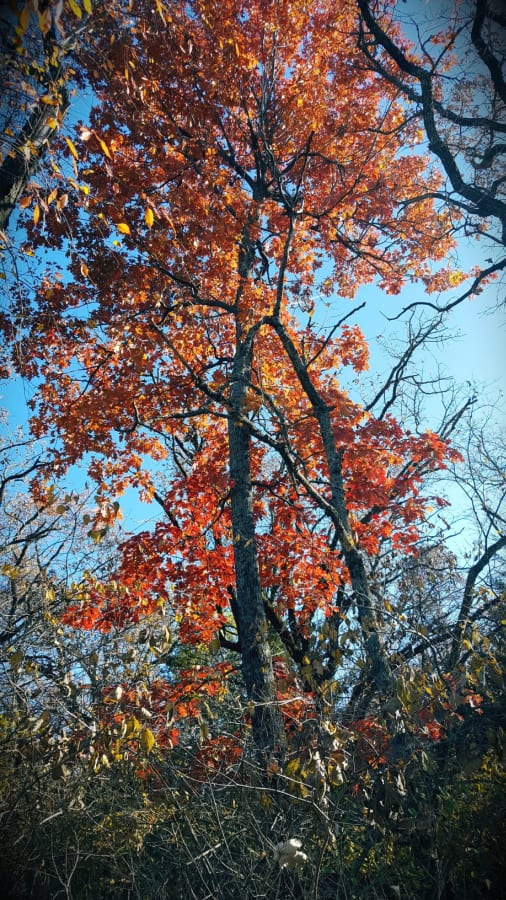
Northern pin oaks grow 70 to 100 feet tall by 60 to 80 feet wide. During drought summers and autumns, fall color is brown to reddish brown. In wet summers and autumns, fall color is brilliant red and very showy.
Black Oak
The black oak, Quercus velutina, is a great shade tree with similar habit and shape to that of red oak. The leaves are also similar, making identification difficult. However, unlike other members of the red oak group, the bark is blocky and very dark.
I have some nice black oak trees in the woods around my house and I love seeing them. The bark is indeed dark and the fall color is red. Mature trees grow 60 to 80 feet tall and wide. There are no cultivars available, yet seed-grown trees can be found.
Willow Oak
The willow oak, Quercus phellos, is a medium to sometimes large oak tree. It grows natively throughout the southeastern United States. The leaves are narrow and do resemble those of a willow tree. This makes their fall cleanup easier and they are often used as street trees.
These oaks grow 60 to 100 feet tall and wide, depending much on location. Their fall color is yellow to bronzy-orange. Acorns are small, also helping in making them a good street tree. There are several cultivar available, though not widely known.

Shingle Oak
The shingle oak, Quercus imbricaria, is a nice shade tree with shiny green leaves, narrow but not as much as willow oak. It grows natively throughout the upper Midwest and into the eastern Great Plains.
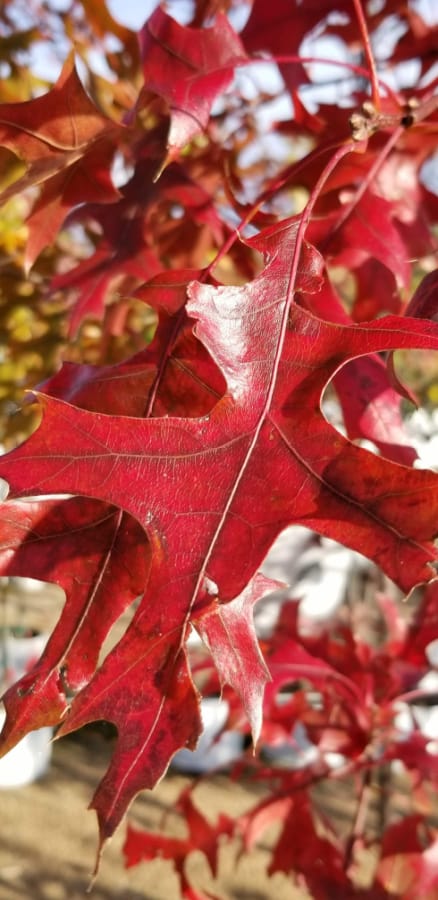
They grow 60 feet tall and wide, though there are larger specimens. The fall color is dirty yellow to yellow-brown. They are fairly fast growing, as much as 2 feet per year in some locations. There are no cultivars; they are seed grown in the nursery.
Scarlet Oak
The scarlet oak, Quercus coccinea, is a nice, pyramidal shade tree with the best fall color of the oaks. We have specimens in the arboretum here that hold their color for almost 2 months. Scarlet oaks grow natively throughout the Mid-Atlantic region and west sporadically through the Midwest.
They grow 70 feet tall by 40 feet wide, holding that pyramidal form as they age, unlike other species. Unlike southern pin oak, scarlet oaks are more tolerant of high pH soils. They are very drought and heat tolerant. The cultivar ‘KC Infraray Red’ was selected by Doug Grimm and is a very nice tree.
Sawtooth Oak
The sawtooth oak, Quercus acutissima, is our one nonnative oak on this list. There are other nonnatives which do well in our area, but I will not discuss them today. I like the sawtooth oak, because its leaves look like saws and the tree grows fairly quickly.
This tree grows 60 feet tall and wide with larger specimens. It is native to east Asia, but is adaptable and is weed in some state forests. It does have some issues with iron chlorosis in high pH soils, but is very drought tolerant. There are a few recognized cultivars including ‘Gobbler’.
Conclusion
This is not an exhaustive list of oak trees by any means. However, you will find many that will grow well in the Central Great Plains and Midwest regions.
Happy planting!
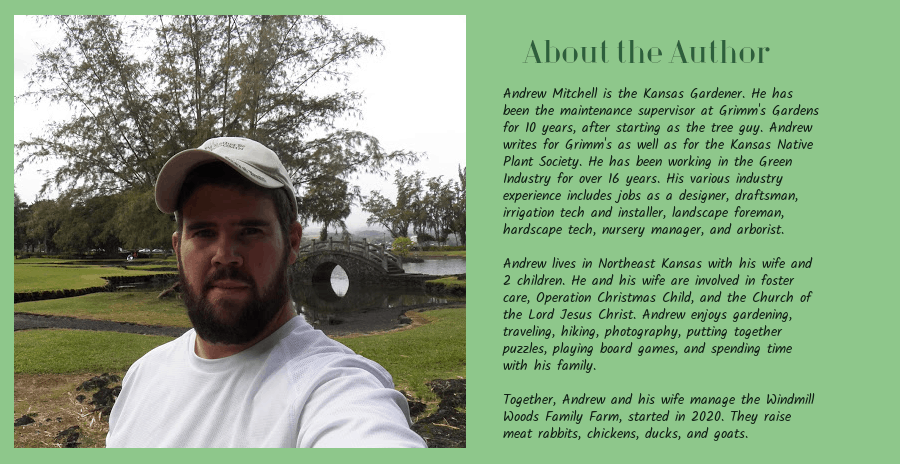
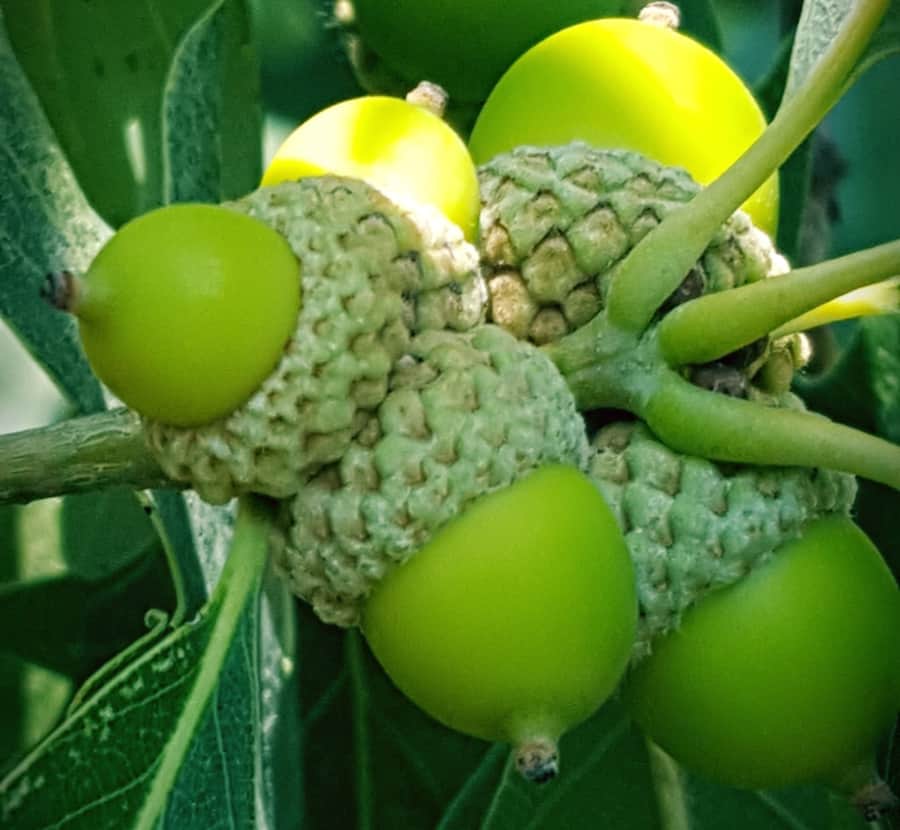



Will you have any sawtooth oaks available this spring?
We’re looking to add some small oak groves in our large yard (MN). We have oaks all over the neighborhood in forested areas on people’s properties and along a river. We definitely have bur oak, northern white oak, white swamp oak, northern pin oak and/or black oak, and red oak. When planning an oak grove planting, should I add a variety of oak species or a single species? I understand that having more than one of a species can be necessary for effective pollination and acorn production. But other than that, are there benefits or drawbacks to planting a variety of oaks or a single oak species or is it purely personal preference?
Hi Sarah, thank you for your question. I would recommend planting not only more than one species, but species from separate types. Oaks are broken into 2 sub categories, Red and White Oak Groups. It is important to diversify a planned grove of trees in order to ward off potential diseases and pests. While it is true than most of the oaks share similar insects, there are variety of diseases which are limited to each sub group. For example, Bur Oak Blight (BOB) does not affect the Red Oak Group. Also, I have noticed that there are fewer gall species which attack red oaks versus white oaks.
In short, I would plant a variety of oaks, picking from the ecoregion I live in, choosing locally native species. You could also add a few cultivars and some native but not local species of oaks for more diversity, as long as they are hardy to your area.
Happy Planting!
– Andrew